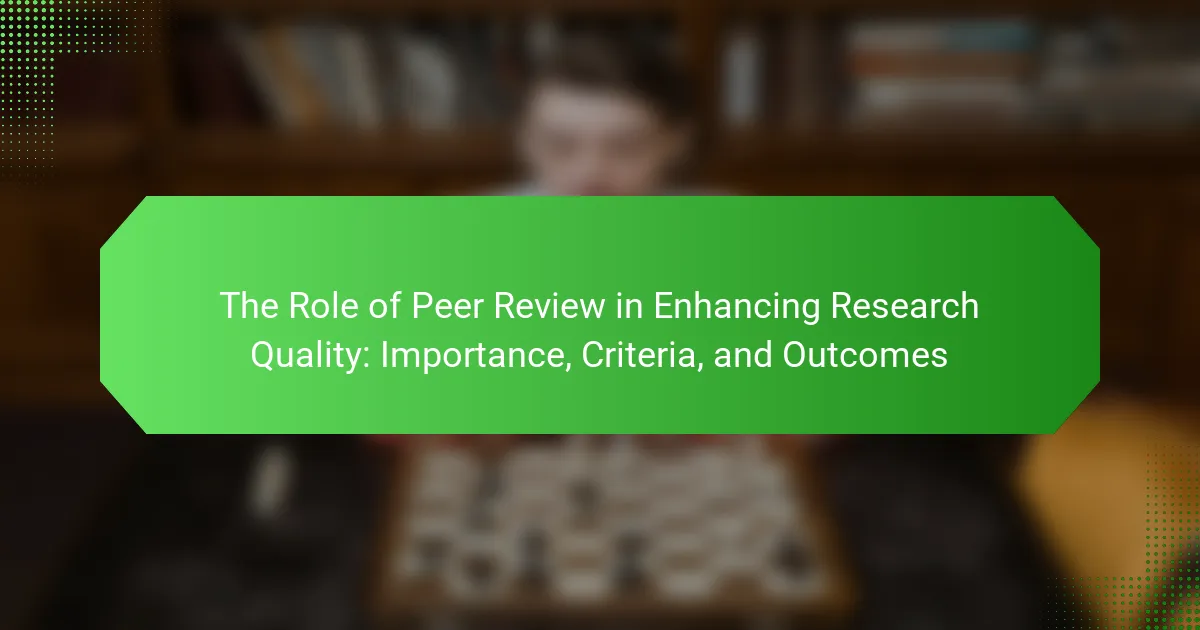Peer review is a vital process that enhances the quality and credibility of research by subjecting it to evaluation by experts in the same field prior to publication. This mechanism identifies errors, biases, and gaps, ensuring that published studies meet high standards of originality, significance, methodology, and clarity. Research indicates that peer-reviewed articles are more frequently cited and recognized in academia, underscoring their importance in advancing knowledge. The peer review process not only improves research accuracy but also promotes transparency and accountability among researchers, ultimately contributing to the reliability of scientific literature.

What is the role of peer review in research quality?
Peer review serves as a critical mechanism for ensuring research quality. It involves the evaluation of research by experts in the same field before publication. This process helps identify errors, biases, and gaps in the research. Peer reviewers assess the validity of the methodology and the significance of the findings. Studies indicate that peer-reviewed articles are more likely to be credible and reliable. According to a study published in “Nature,” peer-reviewed research is cited more frequently than non-peer-reviewed work. This highlights the role of peer review in enhancing the overall quality and trustworthiness of scientific literature.
How does peer review contribute to the overall integrity of research?
Peer review enhances the integrity of research by providing a systematic evaluation of scholarly work. It involves experts assessing the quality, relevance, and originality of a study before publication. This process helps identify errors, biases, and methodological flaws. According to a study published in the journal “Nature,” peer review significantly reduces the likelihood of publishing flawed research. By ensuring that research meets established standards, peer review fosters trust in scientific findings. It also encourages transparency and accountability among researchers. Overall, peer review serves as a critical safeguard for maintaining the credibility of academic literature.
What are the key principles underlying the peer review process?
The key principles underlying the peer review process are objectivity, confidentiality, and constructive feedback. Objectivity ensures that reviewers evaluate the research based on its merits rather than personal biases. Confidentiality protects the identity of both authors and reviewers, fostering an open exchange of ideas. Constructive feedback helps authors improve their work by providing specific, actionable suggestions. These principles enhance the integrity and quality of published research. Studies show that rigorous peer review can lead to higher standards in scientific publishing.
How does peer review help in identifying research flaws?
Peer review helps in identifying research flaws by providing critical evaluation from experts in the field. Reviewers assess the methodology, data analysis, and conclusions of the research. This process highlights inconsistencies and potential biases. It also ensures that the research adheres to established standards. Studies show that peer-reviewed articles have fewer errors compared to non-reviewed ones. For example, a study published in the journal “Nature” found that peer review improved the quality of research by catching significant flaws before publication. This collaborative scrutiny ultimately enhances the credibility and reliability of scientific literature.
Why is peer review considered essential in academic publishing?
Peer review is considered essential in academic publishing because it ensures the quality and credibility of research. This process involves experts evaluating a manuscript before publication. Peer review helps identify flaws or gaps in research methodology. It also assesses the relevance and originality of the findings. Studies show that peer-reviewed articles are more likely to be trusted by the academic community. According to a 2017 study published in “Nature,” peer-reviewed research has a higher citation impact. This indicates that peer review contributes to the advancement of knowledge. Additionally, it helps maintain ethical standards in research.
What impact does peer review have on the credibility of research findings?
Peer review significantly enhances the credibility of research findings. It involves evaluation by experts in the field before publication. This process helps identify errors, biases, and methodological flaws. Studies show that peer-reviewed articles are more likely to be reliable. Research published in peer-reviewed journals is often viewed as more trustworthy. A 2018 study in the journal PLOS ONE found that peer-reviewed research is cited more frequently. This indicates higher acceptance in the academic community. Overall, peer review serves as a quality control mechanism. It ensures that published research meets established standards of rigor and validity.
How does peer review influence the dissemination of scientific knowledge?
Peer review significantly influences the dissemination of scientific knowledge by ensuring the quality and credibility of published research. It acts as a quality control mechanism, where experts evaluate the validity and reliability of research findings. This process helps to filter out flawed studies and enhances the overall integrity of scientific literature.
Research indicates that peer-reviewed articles are more likely to be cited than non-peer-reviewed ones, demonstrating their impact on the academic community. A study by the National Institutes of Health found that peer-reviewed publications increase the visibility and dissemination of scientific knowledge.
Moreover, peer review fosters trust among researchers, practitioners, and the public. This trust is crucial for the acceptance and application of scientific findings in real-world scenarios. Thus, peer review plays a vital role in shaping the landscape of scientific communication.

What criteria are used in the peer review process?
The criteria used in the peer review process include originality, significance, methodology, and clarity. Originality assesses whether the research presents new ideas or findings. Significance evaluates the importance of the research question and its impact on the field. Methodology examines the appropriateness and rigor of the research design and analysis. Clarity focuses on how well the research is communicated, including the organization and presentation of results. These criteria ensure that published research meets high standards of quality and credibility.
What are the common standards for evaluating research submissions?
Common standards for evaluating research submissions include originality, methodology, and significance. Originality assesses whether the research presents new ideas or findings. Methodology evaluates the research design, data collection, and analysis techniques. Significance considers the impact and relevance of the research to the field. Additionally, clarity and organization of the manuscript are important. Reviewers also check for adherence to ethical standards. These criteria ensure the quality and integrity of published research.
How do reviewers assess the methodology of a study?
Reviewers assess the methodology of a study by evaluating its design, data collection, and analysis procedures. They check if the study design aligns with the research question. Reviewers also look for clarity in the sampling methods used. The appropriateness of the statistical analyses is scrutinized. Reviewers assess whether the methodology allows for reproducibility of results. They examine potential biases and limitations in the study. A well-structured methodology enhances the credibility of the research findings. Reviewers rely on established guidelines to ensure a thorough evaluation.
What role does originality play in the peer review criteria?
Originality is a critical component of the peer review criteria. It assesses the novelty and uniqueness of the research presented. Original work contributes to advancing knowledge in a specific field. Peer reviewers evaluate whether the research provides new insights or approaches. Studies indicate that high-quality journals prioritize originality in submissions. This emphasis ensures that published research adds value to existing literature. Originality also helps prevent redundancy in published findings. Ultimately, it fosters innovation and encourages further research in various disciplines.
How are conflicts of interest managed during peer review?
Conflicts of interest during peer review are managed through disclosure and oversight mechanisms. Reviewers are typically required to disclose any potential conflicts before accepting a review assignment. This includes financial interests, personal relationships, or any affiliations that may influence their judgment. Journals often have policies in place to evaluate these disclosures. If a conflict is identified, the reviewer may be recused from the process. Additionally, editors may assign alternative reviewers to ensure impartiality. These practices help maintain the integrity of the peer review process. Studies show that transparency in disclosures increases trust in the peer review system.
What guidelines exist to ensure impartiality among reviewers?
Guidelines to ensure impartiality among reviewers include conflict of interest disclosures and blind review processes. Reviewers must declare any potential conflicts that could compromise their objectivity. Many journals implement double-blind reviews, where both authors and reviewers remain anonymous. This method minimizes bias based on personal identities. Additionally, journals often provide clear criteria for evaluation, focusing on the quality of the work rather than the authors’ reputations. Training programs for reviewers emphasize the importance of impartiality and fairness in assessments. These guidelines collectively aim to uphold the integrity of the peer review process.
How does transparency in the review process enhance research quality?
Transparency in the review process enhances research quality by allowing for greater scrutiny and accountability. When reviewers disclose their identities and provide clear feedback, it fosters trust in the evaluation process. This openness encourages constructive criticism, which can lead to improvements in the research. Studies show that transparent peer review can reduce bias and increase the rigor of evaluations. For instance, research published in “PLOS ONE” by Lee et al. (2019) indicates that transparency can lead to more balanced assessments. Ultimately, transparency helps ensure that only high-quality research is published, benefiting the entire academic community.

What are the outcomes of an effective peer review process?
An effective peer review process leads to improved research quality and credibility. It ensures that research findings are scrutinized by experts in the field. This scrutiny helps identify methodological flaws and biases. Consequently, it enhances the accuracy of published studies. Peer review also fosters constructive feedback, which can refine research questions and approaches. Additionally, it promotes transparency and accountability among researchers. Studies show that peer-reviewed articles are more likely to be cited and recognized in academia. This recognition contributes to the advancement of knowledge in the field.
How does peer review impact the quality of published research?
Peer review significantly enhances the quality of published research. It involves evaluation by experts in the field before publication. This process identifies flaws, biases, and gaps in the research. Studies show that peer-reviewed articles are cited more frequently than non-peer-reviewed ones. According to a study published in the journal “PLOS ONE,” peer-reviewed research is more likely to meet high standards of scientific rigor. The peer review process also encourages transparency and reproducibility. Overall, peer review acts as a quality control mechanism in academic publishing.
What are the benefits of rigorous peer review for authors?
Rigorous peer review provides authors with critical feedback that enhances the quality of their work. This process identifies weaknesses and areas for improvement in the manuscript. Authors can refine their arguments and clarify their findings based on reviewer comments. Peer review also helps ensure that the research meets the standards of the field. It increases the credibility of the work through validation by experts. Furthermore, rigorous peer review can improve the chances of publication in reputable journals. A study published in the journal “Nature” indicates that peer-reviewed articles are cited more frequently than non-reviewed ones. This demonstrates the long-term impact of peer review on an author’s visibility and reputation in the academic community.
How does peer review contribute to the advancement of science and knowledge?
Peer review contributes to the advancement of science and knowledge by ensuring the quality and credibility of research. It involves the evaluation of manuscripts by experts in the field. This process helps identify errors, biases, and gaps in research. By providing constructive feedback, peer review enhances the clarity and rigor of scientific work. It also promotes transparency and accountability in research practices. Studies show that peer-reviewed articles are more likely to be cited and have a greater impact on the scientific community. Thus, peer review serves as a critical mechanism for validating and improving scientific knowledge.
What challenges are associated with the peer review process?
The peer review process faces several challenges that can impact its effectiveness. One major challenge is the potential for bias among reviewers. Reviewers may have personal or professional conflicts that influence their evaluations. Another challenge is the variability in the quality of reviews, as not all reviewers provide thorough or constructive feedback. The time required for the peer review process can also be a significant issue, often leading to delays in publication. Additionally, the anonymity of reviewers can sometimes lead to unaccountable behavior, such as harsh criticism without justification. According to a study published in the journal “Nature,” nearly 30% of authors reported experiencing bias in the review process, highlighting this ongoing concern. Overall, these challenges can undermine the integrity and efficiency of peer review.
How can biases in peer review affect research outcomes?
Biases in peer review can significantly distort research outcomes. They can lead to the rejection of valid studies while favoring less rigorous work. This occurs when reviewers allow personal beliefs or affiliations to influence their evaluation. For example, studies that challenge established theories may face harsher scrutiny. Conversely, research that aligns with prevailing views may receive undue praise. A study published in PLOS ONE found that biases can affect both the acceptance rates and the quality of published research. This ultimately impacts the reliability of scientific literature. Biased peer review can stifle innovation and slow scientific progress.
What strategies can be implemented to improve the peer review process?
Implementing strategies to improve the peer review process includes enhancing reviewer training and diversifying reviewer pools. Training can increase reviewers’ understanding of evaluation criteria and expectations. A diverse reviewer pool can bring varied perspectives and expertise, leading to more comprehensive evaluations. Incorporating technology, such as automated systems for initial manuscript screening, can streamline the process. Encouraging transparency in reviewer comments fosters accountability and trust. Establishing clear timelines for reviews helps maintain efficiency. Regularly soliciting feedback from reviewers and authors can identify areas for improvement. Studies show that these strategies can lead to higher quality reviews and improved overall research outcomes.
What best practices can researchers adopt for successful peer review?
Researchers can adopt several best practices for successful peer review. First, they should choose appropriate reviewers with relevant expertise. This ensures that the feedback received is informed and constructive. Second, researchers should provide clear and concise instructions along with their submissions. This helps reviewers understand expectations and focus areas. Third, maintaining open communication with reviewers can facilitate a smoother review process. Fourth, researchers should be open to feedback and willing to make revisions. This adaptability can improve the quality of the research. Lastly, adhering to ethical guidelines is essential to maintain integrity in the review process. These practices contribute to a more effective and beneficial peer review experience.
How should researchers prepare their work for submission to peer review?
Researchers should prepare their work for submission to peer review by ensuring clarity and adherence to journal guidelines. They must format their manuscript according to the specific requirements of the target journal. This includes structuring sections such as the abstract, introduction, methods, results, and discussion appropriately. Researchers should also include comprehensive references to support their claims. Prior to submission, they should proofread the document for grammatical accuracy and clarity. Collaborating with co-authors for feedback can enhance the quality of the manuscript. Finally, researchers should prepare a cover letter that summarizes the significance of their work. Following these steps increases the likelihood of a favorable review outcome.
What tips can enhance the likelihood of positive peer review feedback?
To enhance the likelihood of positive peer review feedback, researchers should ensure clarity and coherence in their manuscripts. Clear writing helps reviewers understand the research easily. Structured organization of the paper improves flow and readability. Including thorough literature reviews demonstrates awareness of existing research. Providing detailed methodology allows reviewers to assess the rigor of the study. Engaging with peer feedback prior to submission can identify potential weaknesses. Adhering to journal guidelines ensures compliance with expectations. Lastly, acknowledging limitations shows transparency and credibility. These strategies are supported by studies indicating that well-prepared submissions receive more favorable reviews.
The main entity of the article is peer review, which plays a crucial role in enhancing research quality. The article outlines the significance of peer review in ensuring the credibility and integrity of published research, detailing its principles, criteria for evaluation, and the impact on scientific knowledge dissemination. It discusses how peer review identifies research flaws, manages conflicts of interest, and fosters transparency, ultimately contributing to improved research outcomes. Additionally, the article addresses challenges within the peer review process and offers best practices for researchers to enhance the likelihood of positive feedback.


